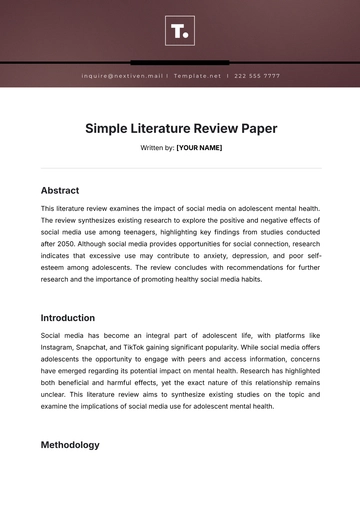Free Investment White Paper

Investment Opportunities and Strategies
White Paper authored by: [YOUR NAME]
Email: [YOUR EMAIL]
Company Name: [YOUR COMPANY NAME]
Position: [YOUR POSITION]
Date: [DATE]

I. Executive Summary
This white paper explores various investment strategies to help individuals and businesses navigate the complex landscape of financial markets. By understanding different investment vehicles and risk management techniques, investors can make informed decisions to achieve their financial goals.
II. Introduction
The purpose of this white paper is to provide a comprehensive overview of investment strategies, including asset allocation, portfolio construction, and risk management. By offering actionable insights and practical advice, this document aims to empower investors to build robust investment portfolios and maximize returns.
III. Understanding Investment Objectives
A. Risk Tolerance
Assessing risk tolerance is crucial for determining suitable investment strategies. Investors with a higher risk tolerance may opt for aggressive growth strategies, while those with a lower risk tolerance may prefer conservative income-generating investments.
B. Time Horizon
Investment decisions should also consider the investor's time horizon, whether short-term, medium-term, or long-term. Longer time horizons may allow for more aggressive investment strategies, while shorter time horizons may require a more conservative approach to mitigate risk.
IV. Investment Vehicles
A. Stocks
Stocks represent ownership stakes in publicly traded companies and offer the potential for capital appreciation. Investors can choose from a wide range of products or services.
B. Bonds
Bonds are debt securities issued by governments, municipalities, or corporations. They provide fixed-income payments and are often considered safer investments compared to stocks. Common types of bonds include government bonds, municipal bonds, and corporate bonds.
C. Mutual Funds
Mutual funds pool money from multiple investors to invest in a diversified portfolio of stocks, bonds, or other assets. They offer professional management and diversification benefits, making them a popular choice for investors seeking broad market exposure.
D. ETFs
Exchange-traded funds (ETFs) are similar to mutual funds but trade on stock exchanges like individual stocks. ETFs offer flexibility, liquidity, and low expense ratios, making them an attractive investment option for many investors.
V. Portfolio Construction
A. Asset Allocation
Asset allocation involves dividing investment portfolios among different asset classes, such as stocks, bonds, and cash. The goal is to balance risk and return by diversifying across various asset types with different risk profiles.
B. Diversification
Diversification is a risk management strategy that involves spreading investments across different securities, industries, and geographic regions. Diversified portfolios are less susceptible to the volatility of any single asset or market segment.
C. Rebalancing
Rebalancing involves periodically adjusting the allocation of assets within a portfolio to maintain desired risk levels and investment objectives. Rebalancing ensures that portfolios remain aligned with investors' long-term goals despite changes in market conditions.
VI. Investment Strategies
A. Value Investing
Value investing involves identifying undervalued securities trading at prices below their intrinsic value. Value investors seek to capitalize on market inefficiencies and purchase assets with the potential for long-term appreciation.
B. Growth Investing
Growth investing focuses on investing in companies with strong growth potential, often characterized by high revenue and earnings growth rates. Growth investors are willing to pay premium prices for stocks with the expectation of significant future returns.
C. Income Investing
Income investing prioritizes generating regular income through dividends, interest payments, or rental income. Income-oriented investors typically favor stable, dividend-paying stocks, high-quality bonds, and real estate investment trusts (REITs).
D. Momentum Investing
Momentum investing involves capitalizing on trends in asset prices by buying securities that have exhibited strong performance in the recent past. Momentum investors believe that assets that have performed well in the past will continue to outperform in the future.
VII. Risk Management
A. Hedging Strategies
Hedging strategies involve using financial instruments such as options, futures, and derivatives to mitigate investment risk. Hedging can protect portfolios against adverse market movements and reduce potential losses.
B. Stop-Loss Orders
Stop-loss orders are instructions to sell a security when it reaches a predetermined price, helping investors limit losses and manage risk. Stop-loss orders can be especially useful during periods of market volatility or uncertainty.
C. Asset Allocation
Strategic asset allocation is a key component of risk management, as it allows investors to spread risk across different asset classes with varying levels of correlation. By diversifying investments, investors can reduce the impact of adverse events on their portfolios.
VIII. Performance Evaluation
A. Benchmarks
Benchmarking involves comparing the performance of an investment portfolio against a relevant benchmark index, such as the S&P 500 for U.S. stocks or the Barclays U.S. Aggregate Bond Index for bonds. Benchmarks provide a standard for assessing portfolio performance and identifying areas for improvement.
B. Risk-Adjusted Returns
Risk-adjusted returns measure the return on investment relative to the level of risk taken to achieve those returns. Common risk-adjusted performance metrics include the Sharpe ratio, the Treynor ratio, and the Sortino ratio.
IX. Conclusion
Effective investment strategies require careful consideration of investment objectives, risk tolerance, and time horizon. By diversifying portfolios, implementing sound risk management techniques, and adhering to disciplined investment principles, investors can enhance their chances of achieving long-term financial growth and success.
X. References
Graham, B., & Dodd, D. (2009). Security Analysis. McGraw-Hill Education.
Malkiel, B. G. (2015). A Random Walk Down Wall Street: The Time-Tested Strategy for Successful Investing. W. W. Norton & Company.
- 100% Customizable, free editor
- Access 1 Million+ Templates, photo’s & graphics
- Download or share as a template
- Click and replace photos, graphics, text, backgrounds
- Resize, crop, AI write & more
- Access advanced editor
Discover the epitome of professionalism with Template.net's Investment White Paper Template. Crafted with precision, this editable and customizable masterpiece elevates your investment strategies. Seamlessly integrate your insights with our AI Editable Tool, ensuring clarity and coherence. Unlock the potential of your financial ventures with a template designed for success. Experience excellence with Template.net today.





























